CVA made some very impressive claims with their new CVA Paramount muzzleloader, but does it live up to the hype?
I think most hunters and shooters in the muzzleloader world agree that CVA got their attention at the 2019 SHOT Show when the company announced the upcoming release of a new muzzleloader designed for hunting situations at ranges past 300 yards. However, that was a very bold claim and many were skeptical that the new CVA Paramount muzzleloader would live up to expectations.
As anyone familiar with muzzleloaders knows, building a muzzleloader capable of that sort of performance is a tall order. I had my doubts about their claims at first as well, but I was also curious to see how CVA would go about building their new long range muzzleloader.
Fortunately, I’ve gotten to test out a CVA Paramount and see what it’s capable of for myself.
So, what’s the deal? Is the CVA Paramount really capable of delivering the goods on big game all the way out to 300-400 yards? Or is this a case where CVAs marketing department outperformed their design and manufacturing teams?
In this article, I’m going to do a detailed analysis my new CVA Paramount muzzleloader in an effort to answer the above questions so you can make an informed decision on whether or not you should buy one.
Update October 2025: CVA has discontinued the Paramount due to difficulty obtaining Blackhorn powder.
No sweat though: they have replaced the Paramount with their new Endura muzzleloader.
The Endura is essentially an improved Paramount with a few minor tweaks.
The biggest difference between the Paramount and the Endura is the Endura can also use certain types of smokeless powder in addition to Blackhorn 209.
Basically, the Endura has all the features I like about the Paramount (can use magnum powder charges, a great trigger, a rifling twist fast enough to use the PowerBelt ELR, etc.) without being restricted to using Blackhorn 209.
All in all, the Endura is a fantastic muzzleloader that will fit the bill for hunters in search of a long range muzzleloader.
Before we get started, I have two administrative notes.
First, Muzzle-Loaders.com sent me the CVA Paramount free of charge for review and testing afield.
Second, all the links on this site to Muzzle-Loaders.com are affiliate links. This means I will earn a small commission if you make a purchase.
This commission comes at no extra cost to you. This helps support the blog and allows me to continue to create free content that’s useful to hunters like yourself. Thanks for your support.
Now that we’ve got that out of the way, let’s get started.
CVA Paramount Introduction
One glance at the CVA Paramount and it’s pretty clear that this isn’t your granddaddy’s muzzleloader. My first impression was that it looks a whole lot more like a modern precision rifle than a muzzleloader. I’m not the only one who feels that way either.
During a recent trip to the range, a guy a couple lanes over walked over to see what I was shooting. With a confused look on his face, he pointed at my Paramount and said “oh, I thought I saw you shooting a muzzleloader earlier” When I told him that it is indeed a muzzleloader, he replied “THAT is a muzzleloader?!?”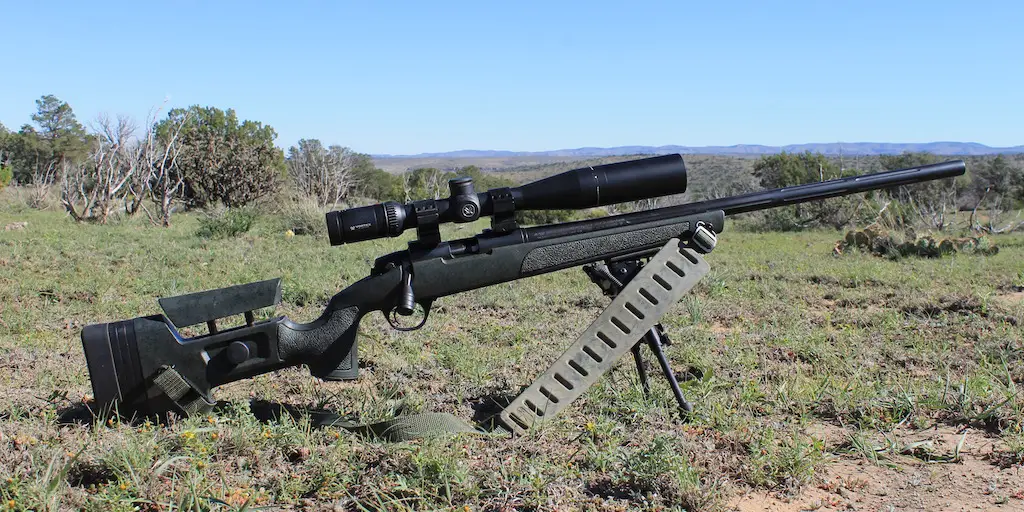 Now, good looks are important and all, but how well does the CVA Paramount actually perform?
Now, good looks are important and all, but how well does the CVA Paramount actually perform?
A muzzleloader must check several performance boxes in order to actually be suitable for hunting big game out past 300 yards.
First, the muzzleloader must shoot a load with a flat enough trajectory that it’s capable of hitting a target with a reasonable amount of holdover at the desired range.
Second, this load must carry enough energy out to the desired range in order to quickly and ethically kill game. After all, this requires more than simply banging steel or punching paper at the range.
Third, the muzzleloader must be accurate enough to consistently hit the vital zone of the big game animal in question at the chosen range.
Fourth, the muzzleloader must also deliver good enough accuracy under realistic hunting conditions. It’s not enough for the muzzleloader to be capable of the required accuracy in the laboratory. Yes, the muzzleloader itself must be well made and capable of a high degree of accuracy, but it must also be built in a manner that facilitates good enough accuracy and precision from the hunter.
Fifth, it must be practical for use by hunters under realistic hunting conditions.
Most muzzleloaders usually shoot a pretty heavy bullet with a relatively low ballistic coefficient at a slow to moderate velocity. Those loads are perfectly fine for many hunters pursuing deer and elk sized game at short range.
However, while it’s certainly possible to hit targets at longer range with a traditional muzzleloader, those loads normally have a rainbow like trajectory that makes applying the appropriate amount of holdover very difficult. Those loads often don’t retain energy very well and aren’t powerful enough for ethical use on game out past a certain range.
To top it off, some muzzleloaders simply aren’t capable of the accuracy necessary to consistently hit game at extended range either.
So, how does the CVA Paramount do in each of these areas and get around the shortcomings most muzzleloaders suffer from?
CVA Paramount Ballistics
Let’s start with ballistics.
Well, while 120 grains of Blackhorn 209 is the maximum safe load for most muzzleloaders, the CVA Paramount can safely shoot up to 150 grains of Blackhorn 209. As you’ll see, this allows hunters to safely shoot bullets at a higher velocity with the CVA Paramount than is the case with most other muzzleloaders.
Additionally, the Paramount is also specifically designed to use the new .45 caliber PowerBelt AeroTip ELR bullet. In case you were wondering, ELR stands for Extreme Long Range. It’s important to note that, while most muzzleloaders use .50 caliber bullets (or a .45 caliber bullet in a .50 caliber sabot), the ELR is a full bore .45 caliber bullet. Basically, PowerBelt went with a smaller diameter bullet because it was easier for them to build a longer and more aerodynamic .45 caliber bullet that weighed less than a .50 caliber bullet with the same BC.
It’s important to note that, while most muzzleloaders use .50 caliber bullets (or a .45 caliber bullet in a .50 caliber sabot), the ELR is a full bore .45 caliber bullet. Basically, PowerBelt went with a smaller diameter bullet because it was easier for them to build a longer and more aerodynamic .45 caliber bullet that weighed less than a .50 caliber bullet with the same BC.
We’ll talk about why that’s important later in the article.
Weighing in at 280 grains, PowerBelt advertises a ballistic coefficient of .452 for the bullet. I personally think that is an overly optimistic BC, but the PowerBelt ELR is still a very aerodynamic projectile that has a significantly higher BC than typical muzzleloader bullets.
This is evident in the photo below comparing a PowerBelt ELR to a .50 caliber 250 grain PowerBelt AeroLite (.174 BC).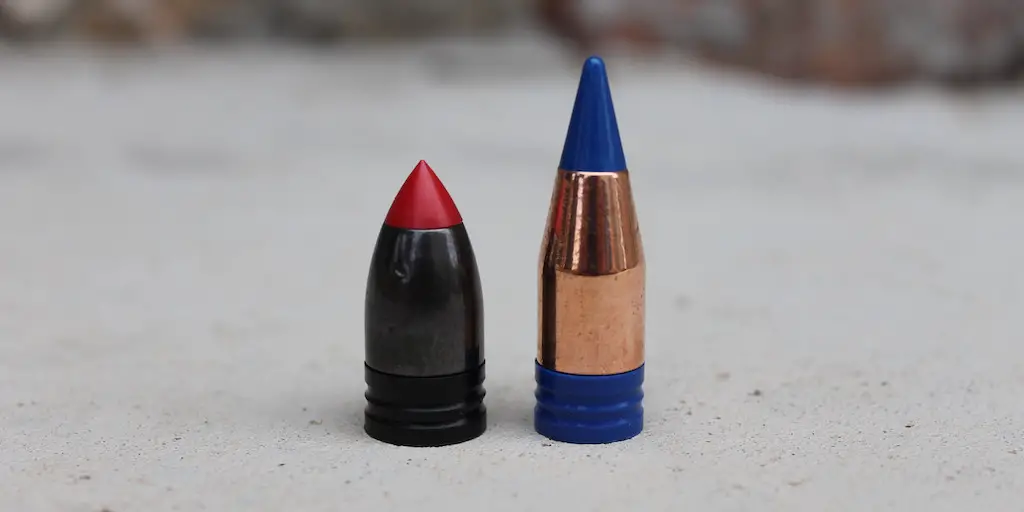 While all black powder substitutes are safe to use in the CVA Paramount, CVA recommends two loads for the Paramount with the 280 grain PowerBelt ELR: 140 grains by volume (98 grains by weight) or 150 grains by volume (105 grains by weight) of Blackhorn 209.
While all black powder substitutes are safe to use in the CVA Paramount, CVA recommends two loads for the Paramount with the 280 grain PowerBelt ELR: 140 grains by volume (98 grains by weight) or 150 grains by volume (105 grains by weight) of Blackhorn 209.
CVA advertises these loads should produce velocities in the 2,200-2,350 fps range.
Note that while CVA does provide three loose powder tubes with volume markings on them, the company recommends carefully measuring powder loads by weight using a scale for the most precise measurement.
Interestingly enough, I was very consistently obtaining velocities right around 2,340 fps with an extreme spread of just 20 fps when using the lighter 140 grain by volume (98 grains by weight) load. Your results may vary though.
In addition to being a little faster than I was expecting, these are among the most consistent velocities I’ve ever obtained while shooting a muzzleloader. However, I closely followed the advice CVA gave in their manual with regards to carefully measuring charges by weight and my efforts clearly paid off.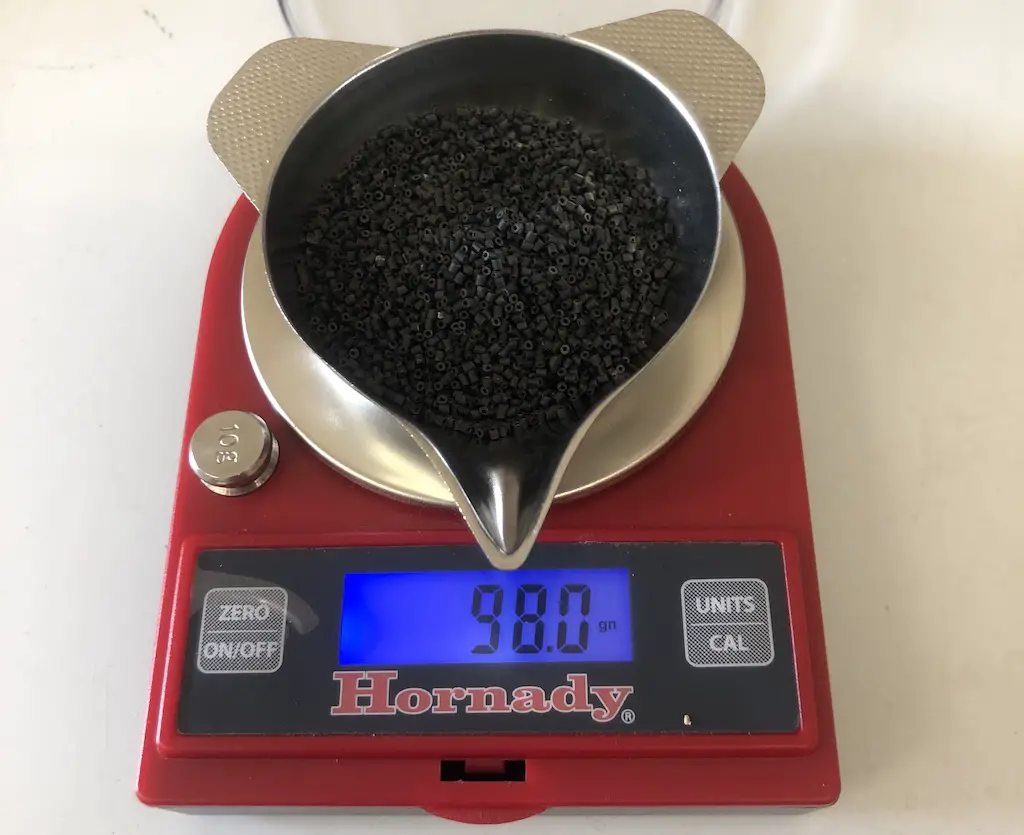 Your exact trajectory will vary depending on temperature, barometric pressure, humidity, etc. But as a general rule of thumb, with a 200 yard zero, that load results in a bullet impact about 3″ high at 100 yards, about 5″ low at 250 yards, and around 14-15″ low at 300 yards.
Your exact trajectory will vary depending on temperature, barometric pressure, humidity, etc. But as a general rule of thumb, with a 200 yard zero, that load results in a bullet impact about 3″ high at 100 yards, about 5″ low at 250 yards, and around 14-15″ low at 300 yards.
This falls well short of the trajectory you’d expect from a flat shooting centerfire rifle cartridge (like the 7mm Remington Magnum for example), but it’s also clear that CVA Paramount is also capable of firing loads with a much flatter trajectory than the vast majority of muzzleloaders.
So, we’ve established that the CVA Paramount can fire loads with a pretty darn flat trajectory (for a muzzleloader anyway). But what about their killing power? After all, we’re talking about using this muzzleloader for hunting, not just for shooting at the range.
Yes, there’s a whole lot more that goes into evaluating the killing power of a given load than just looking at kinetic energy.
That being said, I think we can all agree that you need a whole lot more kinetic energy to quickly and ethically kill a deer (and especially an elk) at a given range than is necessary to simply punch a hole in a piece of paper. Fortunately, the loads fired by the CVA Paramount retain kinetic energy exceptionally well.
If you subscribe to the theory that 1,500 foot pounds of energy is a good minimum threshold for hunting elk and 1,000 foot pounds of energy is a good minimum rule of thumb for hunting deer, then those CVA Paramount loads are acceptable for elk out to 300 yards and out to past 450 yards for deer.
For what it’s worth, the load I primarily use for deer hunting with my CVA Optima (250gr PowerBelt AeroLite pushed by 100gr of Blackhorn 209 for a muzzle velocity of 1,800fps) drops below 1,500 foot pounds of kinetic energy between 25 and 50 yards and below 1,000 foot pounds of kinetic energy just past 125 yards.
As another point of comparison, those loads from the CVA Paramount have more kinetic energy at 400 yards than a typical .44 Magnum hunting load has at the muzzle.
Needless to say, these are very impressive ballistics for muzzleloader.
Like I said, I realize that there’s a lot more involved with determining how a given load will perform on big game than just the kinetic energy of the bullet when it impacts. Among other things, shot placement and bullet construction are also extremely important.
I only brought up kinetic energy because it is a factor that we can easily measure and because kinetic energy can give us an idea how much power there is for expansion and penetration (which are both essential for quick, ethical kills) after hitting an animal at a given range.
How well do these PowerBelt ELR bullets actually perform on game?
That remains to be seen.
At this point, I have not had the opportunity to evaluate their terminal performance on a big game animal. Stay tuned to learn more about how those bullets perform in the real world, but it certainly looks like there’s some good potential there right now.
CVA Paramount Accuracy
Now ballistics on paper are great, but they don’t matter if you can’t hit what you’re aiming at. For that reason, now is a good time to talk about accuracy.
The CVA Paramount uses an internal aluminum chassis stock with a premium Bergara barrel. CVA even took the somewhat unusual step for a muzzleloader of using a truly free floated barrel for improved accuracy. Among other things, this means that the CVA Paramount does not have a barrel collar and there’s no spot to stow the ramrod in the usual place under the barrel.
For this reason, CVA provides a one piece range rod for regular cleaning and loading at the shooting range along with a collapsible ramrod that fits in a small carrying case for reloading afield.
Note: the collapsible compact ramrod will work great for loading the CVA Paramount, but do not try to clean the barrel with it. Use the one piece rod for cleaning instead.
The barrel is made from 416 stainless steel and is nitride treated for corrosion resistance. The stainless steel barrel is 26″ long and has a 1:22″ rifling twist to stabilize those elongated PowerBelt ELR bullets.
Unlike the break action muzzleloaders that CVA is known for manufacturing, the CVA Paramount uses a bolt action instead. Not only does this further contribute to its precision rifle look, but CVA also claims that this particular bolt is specifically designed to completely seal the breech plug and eliminate pressure loss for higher and more consistent pressures when shooting.
Instead of 209 shot shell primers, the CVA Paramount uses Cecil Epps’ VariFlame ignition system. Basically, the VariFlame uses an aluminum adapter that holds a large rifle primer and fits in the breech plug of the muzzleloader.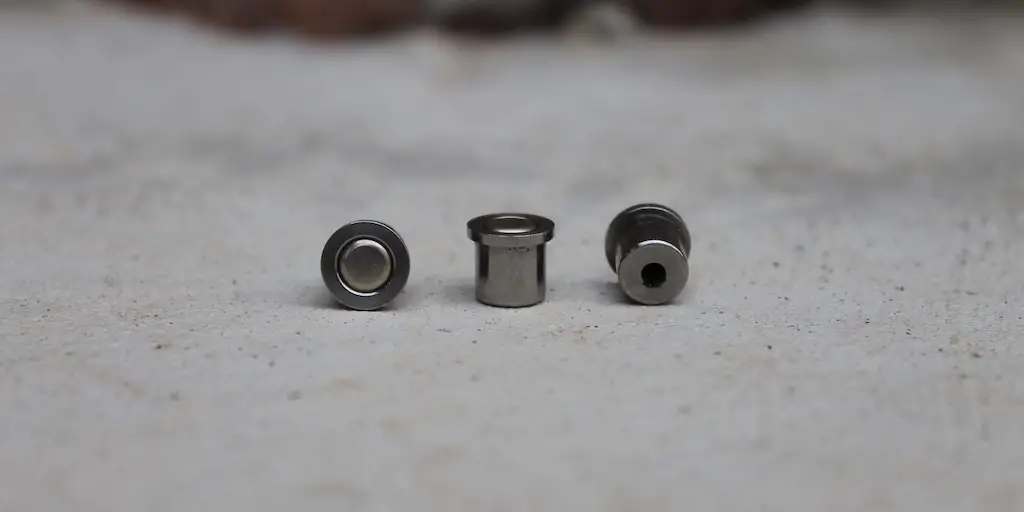 The choice of the VariFlame ignition system was somewhat controversial among many in the muzzleloading community at first due to concerns about gas leakage.
The choice of the VariFlame ignition system was somewhat controversial among many in the muzzleloading community at first due to concerns about gas leakage.
CVA claims they went with the VariFlame ignition because large rifle primers provided a more complete and consistent burn of the powder, which in turn resulted in more consistent velocities and better accuracy. The company also states that they had issues with standard 209 primers swelling and being really tough to remove after firing the heavy powder loads the CVA Paramount uses.
For what it’s worth, I have not experienced any ignition, gas leakage, blow back issues thus far with my CVA Paramount. I have not had any problems with removing primers after firing either, so CVA’s VariFlame ignition system in my particular rifle seems to be performing as advertised.
CVA recommends using standard (as opposed to magnum) large rifle primers for the best overall performance, though both will work. For what it’s worth, I’ve been using CCI rifle primers with excellent results.
So how does the CVA Paramount actually shoot?
In short, accuracy has been outstanding.
I don’t claim to be the world’s best shot, but I’ve been consistently getting sub-1″ groups at 100 yards with the 140 grain by volume load of Blackhorn 209 and the PowerBelt ELR bullet.
I shot the group in the photo below at 100 yards and it measured just under .75″. 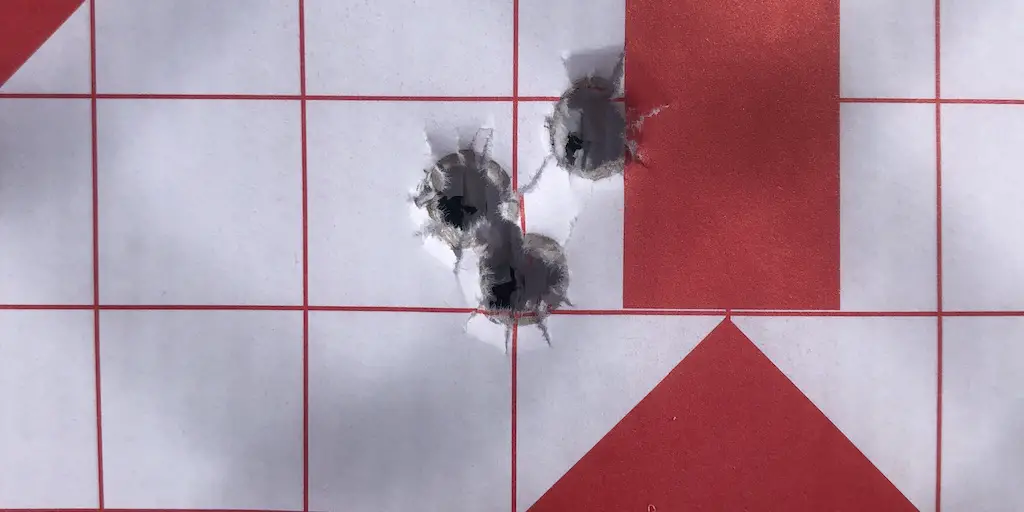 Accuracy at longer range is also wonderful, which is evident in the photo below of a 12″ square steel plate I shot with that same load out of my the CVA Paramount at 325 yards.
Accuracy at longer range is also wonderful, which is evident in the photo below of a 12″ square steel plate I shot with that same load out of my the CVA Paramount at 325 yards.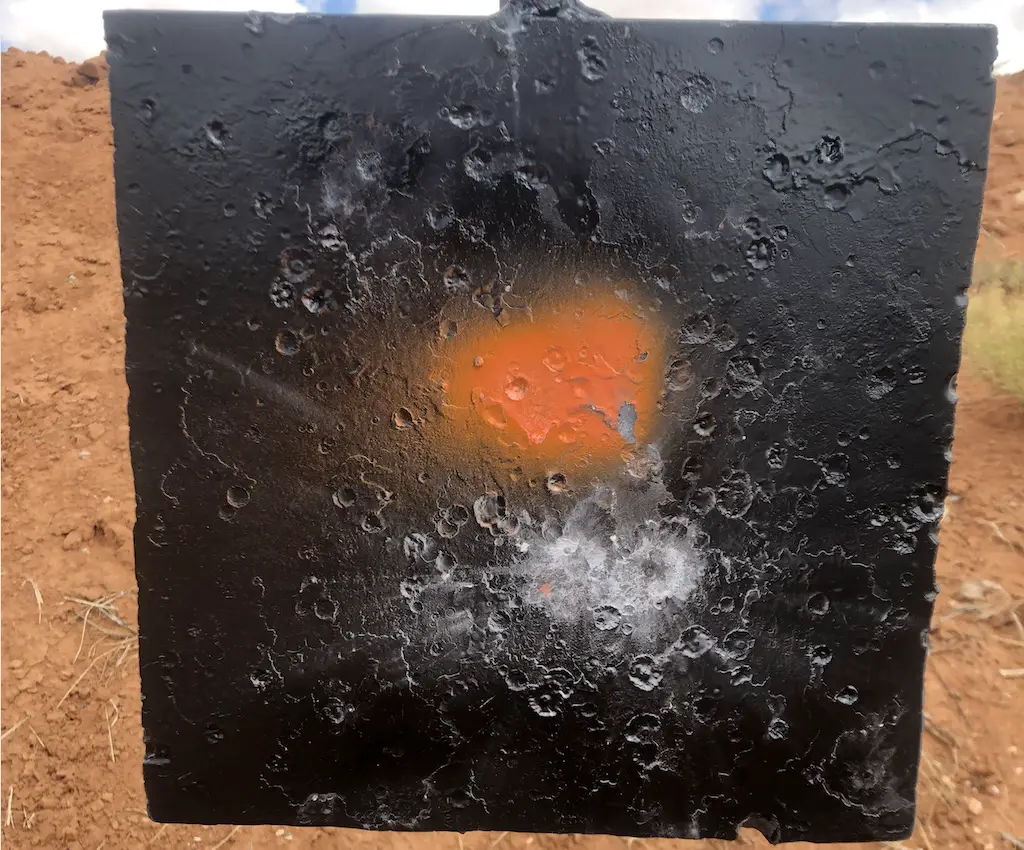 The trigger on the CVA Paramount is excellent and has a very crisp break with minimal creep. While it comes from the factory set at approximately 3 pounds, it’s also adjustable from approximately 2-4 pounds.
The trigger on the CVA Paramount is excellent and has a very crisp break with minimal creep. While it comes from the factory set at approximately 3 pounds, it’s also adjustable from approximately 2-4 pounds.
Bottom line: a good shot can very likely expect tight groups and potentially even sub-MOA accuracy at practical shooting ranges with the CVA Paramount.
Now let’s talk about recoil.
There are four major components of recoil energy: the weight of the bullet, muzzle velocity of the bullet, weight of powder used, and the weight of the rifle.
The “super magnum” loads fired by the CVA Paramount use a very large powder charge to fire a pretty heavy bullet at a relatively fast muzzle velocity. For this reason, a heavier rifle is important to balance out that equation and produce a manageable amount of recoil that most shooters can handle.
CVA advertises a weight of 9.8 pounds for the Paramount without a scope. My rifle tips the scales at about 12.8 pounds with a scope, bipod, and sling. As a point of comparison, my CVA Wolf (which does not have a scope) weights about 6.25 pounds.
That’s part of the reason why the CVA Paramount is relatively heavy: additional weight helps tame recoil to a certain degree.
Now there’s more that goes into determining how much a rifle “kicks” beyond the amount of free recoil energy a given load produces when you shoot it. The design and shape of the rifle stock, how well it fits you, the presence (or absence) of a recoil pad, etc. are all important
The good news is the CVA Paramount stock has a great recoil pad. The Bergara HMR stock is also adjustable for both length of pull and comb height in order to better fit the shooter. Just extend the cheek riser or add/remove the stock spacers on the adjustable stock to achieve the optimal fit and maximum comfort while shooting.
A better fitting rifle will have less perceived recoil and it will also be more comfortable to shoot in general. Both of these factors will probably result in better accuracy as well. 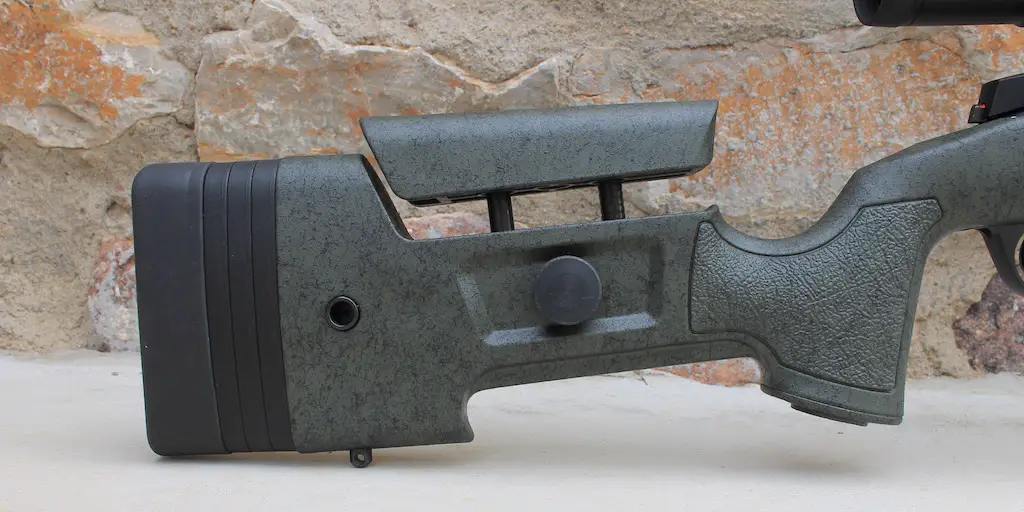 All things considered, I’d say that when shooting the CVA Paramount, recoil certainly gets your attention, but it’s also manageable. It feels like it kicks a little more than my .300 Win Mag.
All things considered, I’d say that when shooting the CVA Paramount, recoil certainly gets your attention, but it’s also manageable. It feels like it kicks a little more than my .300 Win Mag.
In addition to helping moderate recoil, heavier rifles also provide a more stable shooting platform, which is another reason why they’re popular with benchrest shooters. The downside is that really heavy rifles are not a lot of fun to carry around all day, which is why hunting rifles normally are a lot lighter than rifles designed for benchrest shooting.
So, it’s pretty clear that CVA was trying to strike a balance between the Paramount being heavy enough to moderate recoil and assist hunters in placing their shots appropriately, but still light enough that it’s not too difficult to carry through the woods or up a mountain on a hunt.
Yes, the rifle is a little heavy, but I wouldn’t say it’s excessively heavy or will be overly burdensome to use on a hunt. I’ll give you a full report after hunting season gets underway and I’ve spent some time carrying it around for really long periods at a time though.
While we’re on the subject, the CVA Paramount is set up to use a sling as well as a bipod (bipod not included). There are flush-cup sling swivel mounts on both sides of the stock, which is a nice way of carrying rifles like the Paramount that are on the heavy side. The Paramount also comes with a Quake Claw flush-cup sling.
Hunters who like doing things in a more traditional manner will also be pleased to see the conventional quick-release studs (two up front and one on the back) for use with a more conventional sling.
What about maintaining and cleaning the CVA Paramount rifle?
So far, maintenance has been a breeze. Though it does not have a quick release breech plug like the CVA Wolf, Optima, or Accura V2, the Paramount breech plug is pretty easy to remove with the included breech plug wrench. Make sure you lubricate the breech plug threads with an anti-seize compound though, ideally before you shoot it for the first time!
Especially when shooting Blackhorn 209, the Paramount is easy to clean. I normally run a single patch through the barrel between shots for best accuracy, but I’ve also tried shooting it without cleaning between shots. It’s still easy to load and shoots very well, so don’t worry about cleaning in the field if you need to take a follow-up shot.
After a day at the range, just remove the breech plug, run some cleaning patches through the barrel, clean the bolt face, and wipe down all the metal surfaces of the gun. Just like with any other firearm, more in-depth cleaning is necessary on occasion (see manual for details), but regular maintenance is very straightforward. It’s also protected by CVA’s lifetime warranty.
CVA Paramount Final Thoughts
Up to this point, I’ve been extremely impressed with the CVA Paramount. It’s a high quality rifle that shoots very accurately and is a massive step up in performance compared to the other muzzleloaders I’ve hunted with. I don’t think I’m exaggerating when I say that I think it’s one of the best muzzleloaders currently available.
The CVA Paramount really represents the best of both worlds: it offers accuracy, power, trajectory, and an effective range nearly on the level of a centerfire rifle, but it also allows hunters the opportunity to take advantage of lower competition and much easier to draw muzzleloader tags and seasons in many states. With those things in mind, I think the Paramount will really help open a whole new world of hunting opportunities for me.
If that sounds appealing to you, then purchase a CVA Paramount muzzleloader and you can enter that new world of hunting opportunities for yourself.
Note: CVA has discontinued the Paramount due to difficulty obtaining Blackhorn powder.
No sweat though: they have replaced the Paramount with their new Endura muzzleloader.
The Endura is essentially an improved Paramount with a few minor tweaks.
The biggest difference between the Paramount and the Endura is the Endura can also use certain types of smokeless powder in addition to Blackhorn 209.
Basically, the Endura has all the features I like about the Paramount (can use magnum powder charges, a great trigger, a rifling twist fast enough to use the PowerBelt ELR, etc.) without being restricted to using Blackhorn 209.
All in all, the Endura is a fantastic muzzleloader that will fit the bill for hunters in search of a long range muzzleloader.
Keep in mind that in order to get the best performance out of the CVA Endura, you need to do things slowly, carefully, and deliberately. Now, if you’re in a hurry, then you shouldn’t be using a muzzleloader. However, the Paramount requires more care than other muzzleloaders.
Read the manual thoroughly and follow the instructions CVA gives, particularly with regards to weighing your propellant charges and the other steps of loading the rifle. If you do those things, then you’ll probably get outstanding performance out of your Paramount and be able to get full use out of the amazing capabilities the rifle offers.
Here are a couple of other things I’d recommend doing if you elect to purchase a CVA Endura.
First, mount a good scope on it. You can buy a CVA Endura with one of several scopes frome companies like Leupold, Vortex, or Burris that are already mounted and bore-sighted. Those are all great options (I use a Vortex Viper scope on mine), but you can also buy an Endura without a scope and mount a muzzleloader scope of your choosing on it.
Don’t try to get cheap here. The CVA Endura is a high-end muzzleloader and requires a good quality scope for best performance.
Next, but some additional powder tubes and VariFlame adapters. The Paramount comes with 3 tubes, a loading tool for the VariFlame primer casings, and 10 VariFlame adapters. This is a good start, but I like weighing my powder charges and priming my VariFlame adapters at home so I can do those tasks carefully without taking away time from actually shooting at the range.
In that same vein, buy a rubber mallet if you don’t already have one. That will make priming your adapters a whole lot easier.
Next, buy the CVA Paramount funnel, which will also greatly assist with loading and reduce the odds that you’ll spill some of that powder you so carefully measured.
Additionally, buy some more bullets and powder. The Paramount comes with a pack of 15 PowerBelt ELR bullets, but you’ll probably shoot through them faster than you anticipate. Buy an additional pack or two of ELR bullets along with a couple pounds of Blackhorn 209 to ensure you have plenty on hand for practice before you actually head out hunting. Make darn sure you wear quality hearing protection when shooting the Paramount as well, especially if you have a muzzle brake.
BUY POWERBELT ELR BULLETS HERE
Finally, the CVA Paramount comes with a special loading tip for your ram rod to keep you from damaging the bullet tip while loading. Make sure you use it! If you lose it, or if you plan on using the PowerBelt ELR bullets in a different rifle, you can get a new ELR bullet loading tip here.
If you like what you’ve read and are looking for a great muzzleloader that really lets you reach out there while hunting, then I highly recommend purchasing a CVA Paramount muzzleloader for yourself.
The CVA Paramount also made cut for my holiday gift recommendations. To see what other stuff is on the list, check out the following article:
If the CVA Paramount is not your thing, don’t despair. There are plenty of other great muzzleloaders out there and you’ll probably find something you like on one of the two lists below.
9 Best Muzzleloaders For Hunters
5 Best Traditional Muzzleloaders For Hunters
Enjoy this CVA Paramount Review? Please share it with your friends on Facebook and Twitter.
Make sure you subscribe to The Big Game Hunting Podcast and follow The Big Game Hunting Blog on Facebook, Instagram, Twitter, and YouTube.
NEXT: HOW TO HUNT WITH A MUZZLELOADER
Endorsement Disclosure: Per the guidelines of the Federal Trade Commission, the product reviewed here is an endorsement and I received compensation by “in-kind” payment to review the product.
John McAdams is a proficient blogger, experienced shooter, and long time hunter who has pursued big game in 8 different countries on 3 separate continents. John graduated from the United States Military Academy at West Point and is a veteran of combat tours with the US Army in Iraq & Afghanistan. In addition to founding and writing for The Big Game Hunting Blog, John has written for outdoor publications like Bear Hunting Magazine, The Texas State Rifle Association newsletter, Texas Wildlife Magazine, & Wide Open Spaces. Learn more about John here, read some of John’s most popular articles, and be sure to subscribe to his show: the Big Game Hunting Podcast.


Do you have any experience with the 45 cal Powerbelt ELR’s performance on deer? I’d like to hear about terminal performance. Range shot at, muzzle velocity or powder charge, effect on deer meat damage, etc.
Hi can you replace the breech plug to except 209 primers and use white hots in 50 caliber CVA PARAMOUNT I’m only deer hunting not interested in shooting 100’s of yards
I have been using the paramount for two years now. i use 110gr weighed of bh 209. i have taken deer out 410 yds on calm day. i have a nikon p5 3.5x16x50 on it. all i can say is terminal performance on deer is just sick. with a properly placed lung shot the bullet does fragment some but still passes through. this gun is more accurate than most budget cartridge rifles.I have never felt the recoil out deer hunting,but at the range 5 shots is my max unless its in a sled. my gun shoots 2″ high on a cold clean bore. after that its dead on.stays consistant for 5 more before the group opens to 1.5″. buy a spare breech plug or two they do wear a little and let out some gas. also get the magnetic priming tool its a big help. i have never needed a follow up shot with this tac driver. getting 2480 on my chrono.